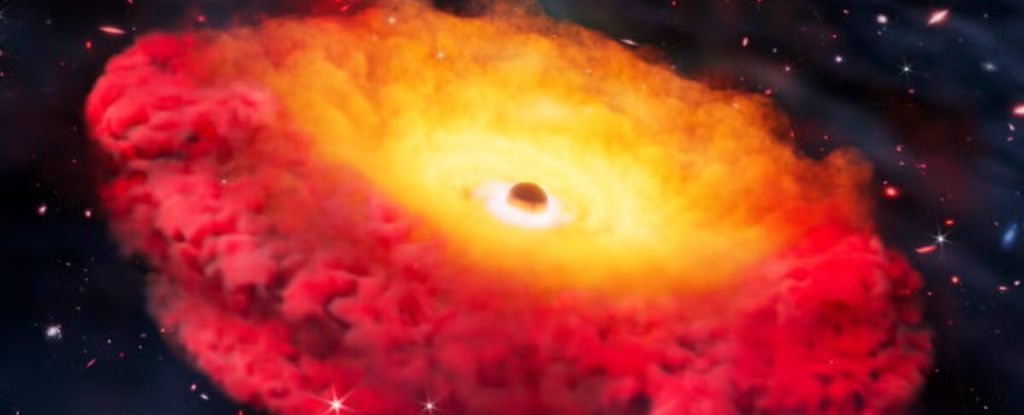Astronomers have confirmed the discovery of the earliest and most distant black hole, identified as residing in the galaxy known as CAPERS-LRD-z9. This massive black hole is estimated to have a mass approximately 300 million times that of the Sun and existed just 500 million years after the Big Bang. At this point in cosmic history, the universe was only about 3 percent of its current age, marking a significant milestone in our understanding of black hole formation and early galactic evolution.
This groundbreaking discovery also sheds light on the enigmatic class of celestial objects referred to as Little Red Dots (LRDs). These bright, small, red objects appeared around 600 million years after the Big Bang and mysteriously vanished less than a billion years later. The James Webb Space Telescope (JWST) has played a crucial role in revealing LRDs through its advanced infrared capabilities, allowing astronomers to explore the universe’s earliest epochs, colloquially known as the Cosmic Dawn.
The newly confirmed black hole at the center of CAPERS-LRD-z9 is classified as an active galactic nucleus (AGN). It appears red due to being surrounded by a luminous cocoon of gas and dust, leading to its characterization as a “black hole star.” The immense gravitational pull of this supermassive black hole accelerates the gas around it to astonishing speeds of approximately 3,000 kilometers (or 1,864 miles) per second, which is about 1 percent of the speed of light. Such rapid movements create unique signatures that help astronomers confirm the presence of black holes using spectroscopy.
Lead author Anthony Taylor, an astrophysicist at the University of Texas at Austin, explains, “There aren’t many other things that create this signature.” Spectroscopy involves splitting incoming light into its wavelengths to create a spectrum that reveals essential information about an astronomical object. In this case, the gas surrounding the black hole emits light waves that become redder when moving away from an observer, indicating the velocity of the object.
The spectroscopic confirmation of CAPERS-LRD-z9 supports the hypothesis that LRDs harbor supermassive black holes. Some of these black holes may reach masses exceeding 10 million solar masses within their first billion years. For context, the supermassive black hole at the center of our Milky Way galaxy has a mass of about 4 million solar masses. The black holes within LRDs may not only be supermassive but also “overmassive,” with mass ratios approaching 10 percent to 100 percent of their host galaxy’s stellar mass. The supermassive black hole in CAPERS-LRD-z9, at roughly 300 million solar masses, constitutes about half the mass of all the stars in its galaxy, a stark contrast to more local galaxies where central black holes represent only about 0.1 percent of their stellar mass.
Despite its enormity, CAPERS-LRD-z9 is so compact that even the JWST cannot resolve its structure, measuring only about 1,140 light-years wide, similar in scale to the dwarf galaxies that orbit the Milky Way. The research team suggests two potential pathways for how a black hole could grow to such a massive size within just 500 million years of cosmic time. One scenario involves a large “seed” black hole growing at the theoretical upper limit known as the Eddington rate, potentially starting with around 10,000 solar masses. Alternatively, a smaller seed, possibly beginning at just 100 solar masses, would need to grow at an accelerated pace, referred to as the super-Eddington rate, fueled by gravitational forces and a dense gas envelope.
These primordial black holes may have originated from various processes, including the collapse of Population III stars, the first stars that illuminated the cosmos, runaway collisions in dense star clusters, or the direct collapse of massive primordial gas clouds. Taylor notes, “When looking for black holes, this is about as far back as you can practically go. We’re really pushing the boundaries of what current technology can detect.”
This research not only confirms the existence of CAPERS-LRD-z9 but also adds weight to the theory that LRDs were transient phenomena in the early universe and could represent a crucial step in galactic evolution, possibly contributing to the formation of the Milky Way itself. The full study is published in the Astrophysical Journal Letters, marking a significant advancement in our understanding of cosmic history.





























































